What do agnolotti from Piedmont, tortelli from Mantua, cappelletti from Emilia and casunziei from Venice all have in common? They are all stuffed. They are all delicious. And they can all be enjoyed along the 700 kilometres of the Ciclovia VENTO between Turin and Venice.
A cycle path unfurls along the Ciclovia VENTO, but so does an Italy that tells its story slowly, on wheels and with the heart. In this interview with Paolo Pileri, a professor in the Department of Architecture and Urban Studies and scientific director of the project, we discover a radical and poetic vision of the territory, one that intertwines engineering and architecture, academic research and everyday stories, sustainability and social regeneration.
Cycling from Turin to Venice means not only travelling along the Po Valley, but restoring ties, local economies, and the gastronomic and cultural heritage. It is a soft revolution, but no less ambitious. More than infrastructure, VENTO is an idea of the future that has the courage to slow down.
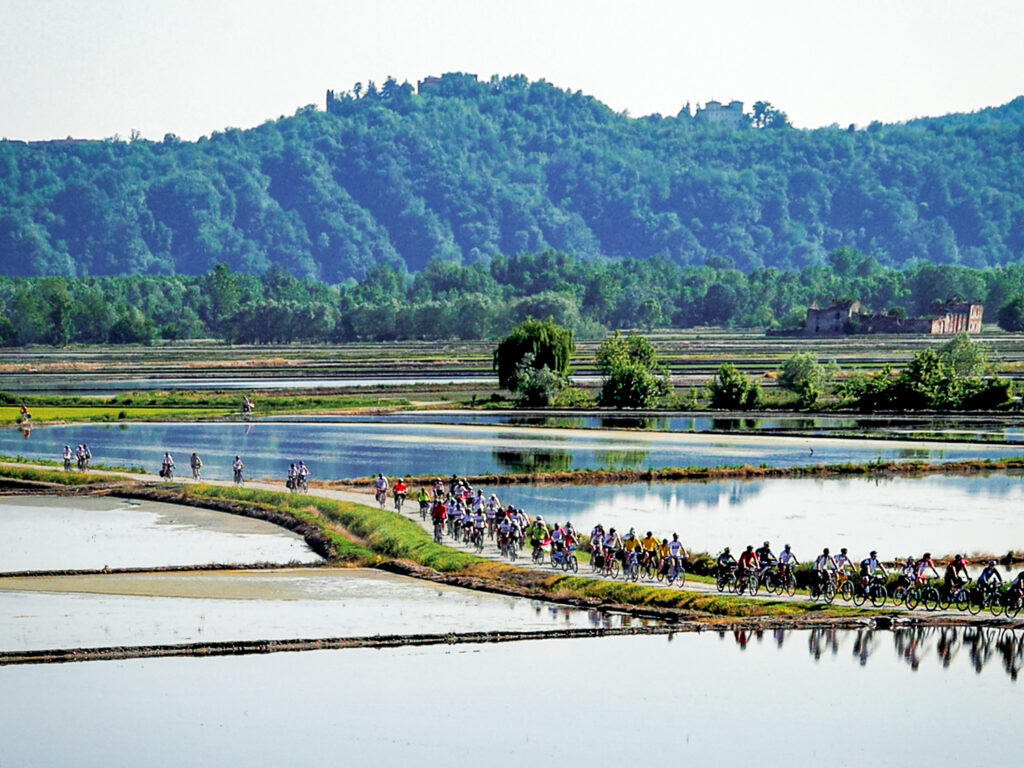
Professor Pileri, can you tell us briefly about your academic and professional career?
I earned my Master of Science in a course that no longer exists, but one that I still remember fondly. It was called Civil Engineering for Land Protection and Spatial Planning. Today it is called Environmental and Land Planning Engineering, which is certainly a lovely name. But I would like to emphasize that ‘land protection’ spoke very well to the mission to care for an increasingly vulnerable landscape and environment.
Since I was young, I wanted to become a researcher and professor, and I guess I was lucky. Today I am excited to teach both Environmental Engineering and Architecture. These are two seemingly distinct worlds, but they need to interact better and more often. This intersection — between sustainable mobility and conscious land use — is precisely where the VENTO project developed.
How has your career path evolved between teaching and research?
On the research front, I have always worked in international projects, especially in Northern Europe. I am currently involved in a Horizon project focused on land protection in collaboration with French/German and Dutch research groups.
In parallel, I am also working on slow mobility. In particular, I coordinate a small hub within the MOST project for sustainable mobility. We are creating a manual for designing charging stations for electric bicycles used by tourists. This is a current, crucial topic that requires reconsidering design methods according to user needs. Such users are often older and have specific needs, such as recharging their electric bicycles at strategic points, given the morphology of the terrain.
This work leads us to reason from a dual perspective, looking at both engineering and architecture. We want to create not only functional infrastructure, but also pleasant places designed to offer a high-quality break. We like to imagine charging stations in squares, parks or public spaces, so that the charging time also becomes an opportunity to interact with towns, people and the environment.
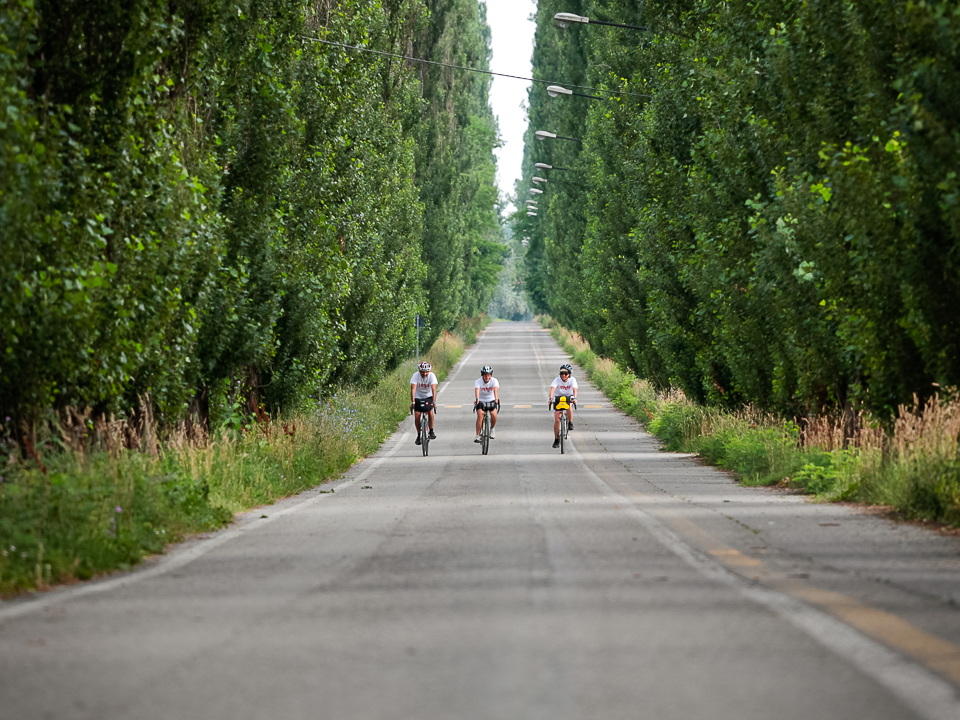
How did your interest in the relationship between the territory and slow mobility come about?
Research ideas often arise in curious and unpredictable ways. I always think of the story of a well-known physicist who said that the intuition that earned him the Nobel Prize came to him while swimming off the Gulf of Lion during a gap year. This image is very descriptive of how certain things develop in a lateral, personal and unexpected way, but always on well-kept ground: the ground of study and research.
My interest in slow mobility also came from a family experience: since my daughters were little, I have always loved cycling with them. Those trips together were important for developing a sensitivity about places, the landscape, slowness and the vulnerability of people, in this case children. A comparison with cases abroad was also decisive. In the late 1990s and early 2000s, I spent periods in Northern European countries such as Finland, Denmark and Sweden. I was struck by the extraordinary attention they devoted to cycling, to the point that they complicated life for cars to facilitate the integration between cycling and public transport. It was a great stimulus.
What role did European examples play in shaping your vision?
Studying abroad allowed us to understand how cycling was also used as a social tool in countries such as Germany. After the fall of the Berlin Wall, for example, many investments in the cycling network were aimed at reducing inequalities between east and west. We discovered this when we interviewed officials from the German Ministry of Infrastructure, who told us how extensive cycle routes were designed to stimulate tourism from west to east.
These considerations also strongly influenced the VENTO project, which envisions a cycle path along the Po River, crossing inland areas that are often marginal or becoming depopulated. The idea is to bring slow, respectful tourism to these territories, generating relationships, microeconomies and awareness.
We also studied a case in Spain, the Camino de Santiago. There, public investment in urban regeneration is tied to precise spatial planning choices. If a municipality along the Way wants to receive funds to recover its historic centre, it must renounce certain developments (such as logistics centres or shopping centres), because they are not consistent with the spirit of the route.
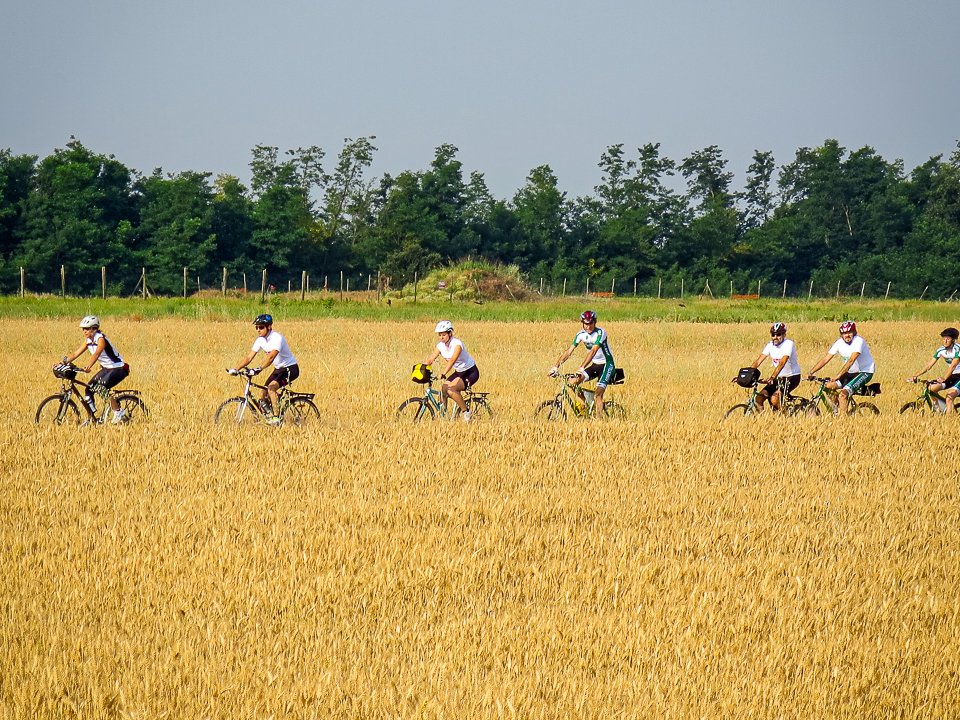
How are these principles translated into your research projects and territories?
All these experiences led us to propose a model of regenerative rather than performance cycling in Italy. We are not interested in creating routes for athletes in technical shirts to speed from Venice to Turin in three days. We care who stops, observes, develops a relationship with various places. And that means having a vision of the territory.
One of the most practical projects is TWIN, which is designed to create ‘solidarity huts’, hostels run by vulnerable people — those who are unemployed, have disabilities or are in delicate situations — providing them with job opportunities by welcoming cyclists or walkers.
We have already built one in Cisa Pass in collaboration with the CAI through a PolimiAward call. Another, called Casa Peroni after the square where it is located, recently opened along the VENTO cycle path in the municipality of Castelnuovo Bocca d’Adda.
This approach requires time and patience. We teach this at the Politecnico and talk about it at conferences and seminars and in our articles. We try to convey the idea that people traveling slowly have a different view, a view that deserves attention. I always remember that the Italian word for ‘slowness’, ‘lentezza’, holds another meaning: ‘lens’. It is as if to say that by slowing down, we can read the environment and territory correctly. It is therefore not a question of developing projects to meet market demands for the ‘average’ tourist, but of rethinking services, landscapes and relationships through a new sensitivity. First of all, VENTO aims to be a thread that mends beauty, a fulfilling way to talk about sustainable mobility and territorial regeneration.
As someone from Mantua, I am very familiar with the situation in Viadana and areas along the Po, which are often overlooked by traditional tourism. Do you believe that slow tourism can truly represent a concrete opportunity for these areas?
I’m glad you asked, because I was in Viadana three weeks ago to give a lecture at the IAL on the VENTO project and the BorghiLenti project. At the same time, a stage of the Giro d’Italia was also being held there. It is incredible how, in a second, all the reasoning we try to advance is set aside by this logic of ‘branding’, where it seems that the presence of a great event is all that is needed to change the economic fortunes of a place.
This is where you can see the difference. With VENTO and the other projects, we have worked long and patiently, building the projects over time. They need to be thoroughly understood and present a new look for the towns that is not fleeting, not wishful thinking and not temporary. We bring this proposal not only to people who walk or cycle — fortunately a growing group — but also and especially to people who live in these areas, those who offer services and political decision-makers. They are the ones who can really make a difference, because they know the places and people and are present every day.
What we always say is that these projects are not turnkey, they do not work on their own. They only work if there is openness, collaboration and a vision. This is why the Politecnico proposes a technical/scientific phase of local support, and we always look for interaction with local institutions, as these are what enable change.

How was the VENTO Bici Tour born and what did it represent along the VENTO cycle path?
VENTO Bici Tour was a unique, beautiful and challenging experience that lasted for ten years. Every year in spring, we would start out on our bicycles — from Turin, Venice, once even Milan — and ride what would become the VENTO cycle path. We did it when it didn’t exist yet, but we were already imagining it and had traced it out. We followed that path, crossing the land, stopping in the towns, meeting people who live and work there. This was the test for a participatory workshop designed for pedalling, one that is unique in Italy.
We talked to mayors, restaurateurs, agricultural and cultural businesses. And together with them, we often organized parties in the squares, small events that became opportunities for reflection, interaction and storytelling. It was a concrete way to show that VENTO not only provides cycling infrastructure, but is also a territorial and cultural project.
The first year there were six of us. In 2019 we reached 250 people who paid to participate, forming a sort of temporary community united by the desire to imagine another idea of mobility and local development. We also cycled together with ministers, the RECTOR at the time and regional presidents, because we wanted — and we still want — this project to be fully understood, even by those making the decisions.
The VENTO Bici Tour was a way to make it clear that cycle paths are not only for cycling, but can serve to mend territories, build bonds and bring out the beauty of a place. It was fascinating, but also very challenging, both from an organizational and economic point of view. But I’d do it all again. Because it left a mark. And because it showed that we can also do research and teach by cycling among the towns and nature. This is also the Politecnico.
Let’s talk about the VENTO project. What is its guiding vision?
VENTO is an acronym for Venezia-Torino, but it is deliberately written together and capitalized. It is not just two points on a map, but a continuous line, because the experience of slow travel is experienced in between or along the way, rather than at the start or end.
It is a cultural project more than infrastructure. The cycle path runs for about 700 km, mostly on the bank of the Po River, with cyclists in an elevated and panoramic position. It crosses 120 municipalities, over 500 localities and more than 40 waterways, joining areas that are rich in historical, agricultural, cultural and gastronomic heritage.
VENTO serves to mend forgotten territories, connect people and places and enhance traditions and local identities. Even food becomes a common thread. On one of the tours, for example, all the recipes for stuffed pasta from Venice to Turin were collected and brought to the Salone del Gusto, demonstrating how even the history and traditions of food are part of the cultural heritage.
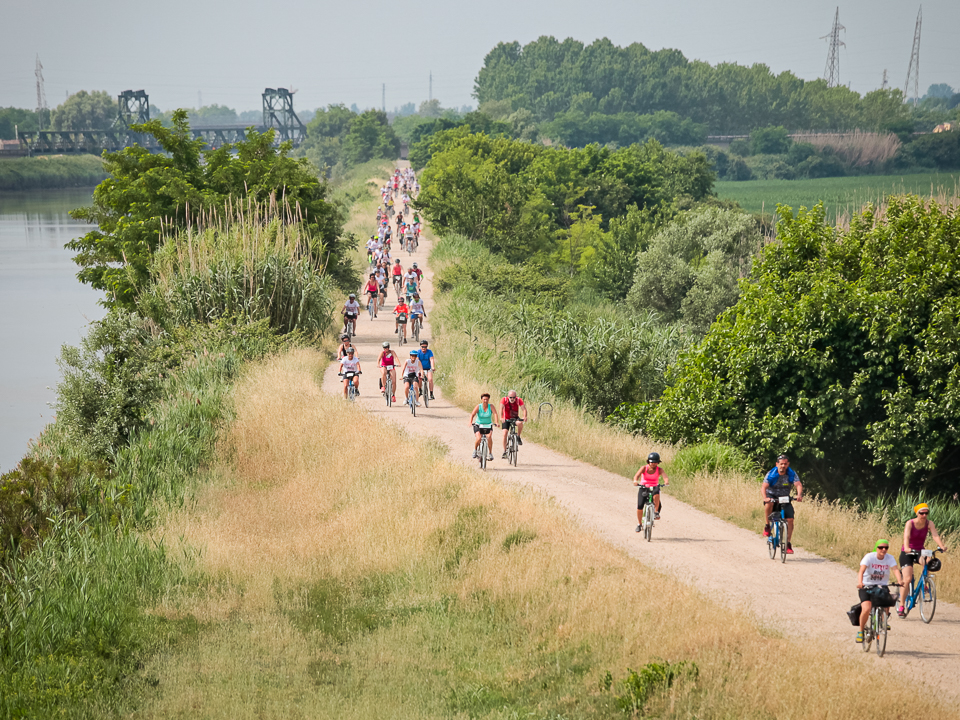
What does VENTO mean from a political and social point of view?
Since 2010, when VENTO was launched at the Politecnico di Milano, it has shown that a good design idea can generate public resources and that the opposite is not necessarily true. Due to the persistence of the research, VENTO was welcomed by the government in 2016, which had established the Sistema Nazionale delle Ciclovie Turistiche [National System of Tourist Cycle Routes], introducing a new item for investment in the national budget.
The project also required complex choices, such as paving some sections to ensure accessibility for people with disabilities — for example, visually impaired people on tandem bicycles. This choice was difficult because it led to land consumption, but with the conviction that we were extending the right to slow mobility to even the most vulnerable people.
VENTO is therefore a technical, cultural and political challenge. It aims to affirm the right to slowness without demonizing speed, but rather by recognizing that we cannot think of society only according to speed. Slowness also makes room for human and social growth, and it must be designed and defended. Without being the child of a lesser god.
Why did you choose the route along the Po River for the Ciclovia VENTO?
The Po River was chosen for several reasons. First of all, by studying European models, we found that about 40% of large cycle paths run along rivers. This is because rivers offer open and pleasant landscapes with a lot of water that makes the journey more pleasant. In addition, lowland rivers such as the Po have minimal slopes, which is ideal for people traveling with loaded bikes or families, as is the case with more than 25% of European bicycle tourism.
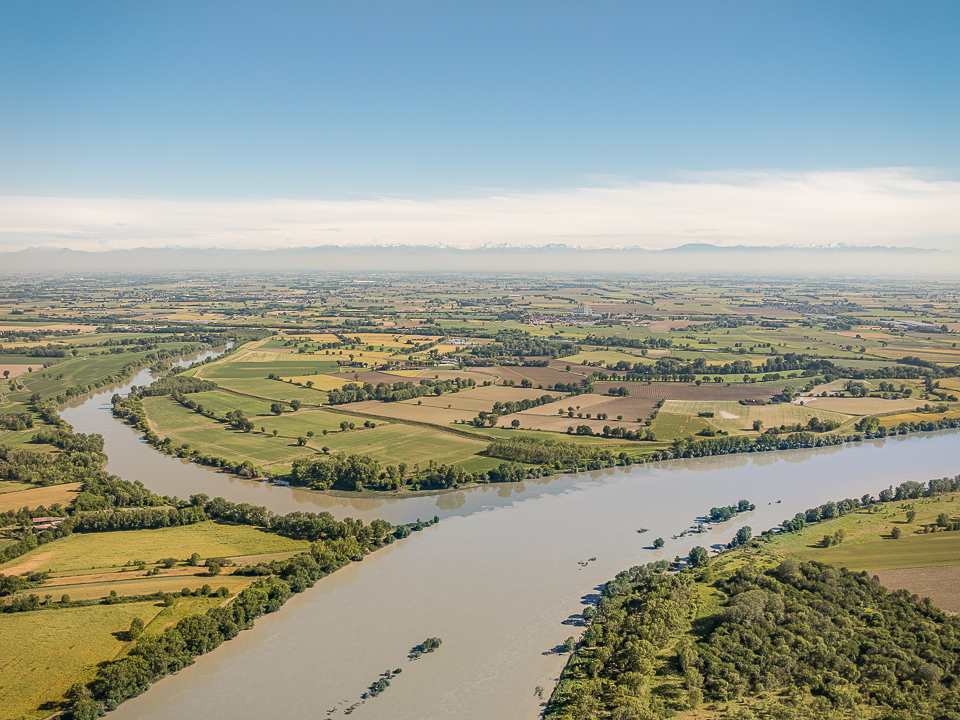
The Po is also the most important river in Italy, and there were already some portions of cycle paths along its course: 5-7% could already be cycled, and another 25% was practically so. This was a very good starting point. Then, the Po landscape is the history of Italy in motion. From Turin to Venice, you find the Savoys, the Renaissance, maritime republics, agriculture, battles…until you reach Milan, which is connected to it by a stem.
The choice of the route is affected as much by studying planning techniques as by personal experience (but you cannot rely only on the latter). I had already cycled along other European river routes — such as the Drava, the Danube, the Inn — often with my daughters. This helped me to understand the effectiveness of the model, as well as testing quality and accessibility.
What role did the Politecnico play and how has the VENTO project evolved over time?
I’d like to recall that VENTO is the result of work conducted by fantastic, cohesive research group at the Politecnico. Once the idea was finalized and the feasibility verified, we answered a call by the Lombardy Region relating to Expo 2015, since VENTO was and is a light thread that runs through and illustrates one of the most important Italian agricultural landscapes. We won a scholarship that allowed us to complete our studies and start the preliminary project, as well as carrying out intense participation and communication activities. But as we said before, to be realized, an idea must be supported. This is why VENTO Bici Tour was born: to explain the project — directly in the territory — to those who must make decisions and implement it
Since 2016, the Ministry has opened calls for proposals to design VENTO, asking the Politecnico to accompany designers in the subsequent phases. Cycling is not sub-infrastructure. It is real infrastructure that requires bridges, walkways, complex engineering and architectural solutions. This is precisely why we have opened a course at the Politecnico in the urban design of tourist cycle paths, because it is a serious, technical issue with an enormous transformative potential.
Can the VENTO project serve as a replicable model?
Absolutely. I am so convinced of this that I worked as scientific advisor for a year and a half at the Ministry of Infrastructure precisely to help transfer this experience to other areas. However, one thing is essential: courage. This is also a keyword in the Laudato Si’ encyclical. In our case, it means that research does not neglect its interaction with civil and political commitment but instead cultivates dialogue and introduces long-range visions.
To replicate a project like VENTO, an idea is not enough. We need stable funding; we need dedicated technical teams within ministries and regions; we need new management bodies because individual municipalities cannot do it alone. They don’t have the strength or structure to handle such long and complex cycle paths.
VENTO would also be good for Italy from an economic and employment point of view. Along the Danube, for example, 1 km of cycle path supports about 6 jobs and generates an annual economic income ranging from €250,000 to €350,000. This is because cyclists stop, sleep, eat and visit. They create local economies that are anything but ‘micro’.

As researchers, our profession is to deal with the impossible, not the easy. I’m not afraid of the difficulty of the project. What worries me is that sometimes, the people making decisions at various levels fail to pay attention to things that do not have an immediate return in terms of profit, but rather a social, cultural or environmental value. Instead, such projects must be curated, financed and supported, precisely because they create a better future. You have to be patient.
Is there anything about your work that particularly excites you today?
Absolutely. I often say this to my colleagues, too: there is nothing more beautiful than devoting oneself to citizens and the territory. I have about 150 meetings on my agenda each year, mostly with committees, associations and ordinary people, often in peripheral or rural settings. Whether it’s cycling, walking or land protection, my studies and research continually lead me to interact with local communities, listen to them and bring them tools, ideas and solutions.
For example, last year I participated in a walk organized by Repubblica Nomad, an association that walks through rural areas in Italy to meet and listen to those who live there. These moments are full of energy and interaction, and — let me tell you — often richer than some conferences with technicians, although those are also necessary.
I also remember the Biodiversity Festival, where we staged a small show together with Erica Boschiero, a singer-songwriter. She played and I read texts I had written about the land. The public’s affection and the opportunity to see people approach complex issues through our communication effort is very rewarding. It is the most precious ‘currency’.
I also remember the Biodiversity Festival, where we staged a small show together with Erica Boschiero, a singer-songwriter. She played and I read texts I had written about the land. The public’s affection and the opportunity to see people approach complex issues through our communication effort is very rewarding. It is the most precious ‘currency’.
What advice would you give to the young people reading this?
I would say this: believe in your dreams, even if they don’t seem immediately profitable or convenient. We are often afraid to choose what makes us happy, because everything around us tells us that we must perform, win and be fast. But it’s a crazy cog.
It takes courage, if only to slow down and follow what makes us wake up happy in the morning. I see it in my students. Many have beautiful dreams, but they keep them hidden because they think they are not ‘useful’. I say: make roads, invent paths, have the courage to be original. Do not be afraid of difficulties or those who say that ‘so much time is lost because things are different’. I always read them a couple of sentences by Stefano Massini that I carry in my heart: ‘And since they wouldn’t understand me, shouldn’t I try? Even if it’s right, do I have to pretend it’s not because they wouldn’t understand me? Do you realize what you are saying…? Everything that depends on an idea…is it not good just because it is not easy to say?’ VENTO, which everyone said was a difficult and impossible idea, was developed by following these words.
Finally: read, read, read. Reading opens new thoughts, drives debate and trains wonderful people. This is fundamental today, because it forces us to move more slowly in a world that wants us to always be faster and more elusive.
I often quote a philosopher I admire, Martha Nussbaum, who said that if a student was able to criticize the university and even herself at the end of her course, then she had done her job well. This is the heart of the matter: helping people think for themselves. And to do that, you have to feed on deep, complex, slow thoughts.
